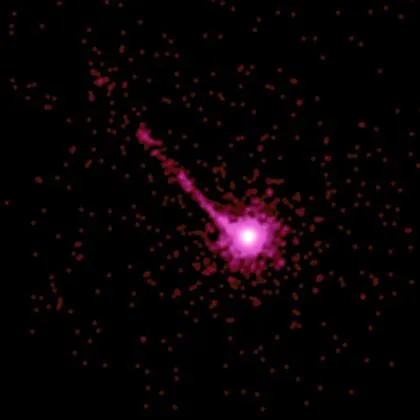Astronomers Discover the Most Explosive Black Hole Yet
The newly discovered quasar spews an amount of energy equivalent to more than two million suns
/https://tf-cmsv2-smithsonianmag-media.s3.amazonaws.com/filer/SurprisingScience-BlackHole-631.jpg)
The stereotypical black hole is a region of space that powerfully sucks in anything that comes near. While that’s sort-of true, many black holes are surrounded by quasars: dense, matter-rich regions at the centers of galaxies that eject astonishing volumes of radio waves, light and many other forms of energy.
Astronomers, using data from the European Southern Observatory‘s Very Large Telescope in Chile, have spotted a quasar (labelled SDSS J1106+1939) that is spewing more energy than any one found previously. “The rate that energy is carried away by this huge mass of material ejected at high speed from SDSS J1106+1939 is at least equivalent to two million two million million times the power output of the Sun,” said Nahum Arav of Virginia Tech in a statement. “This is about 100 times higher than the total power output of the Milky Way galaxy—it’s a real monster of an outflow.”
Quasars, some of the most luminous and energetic objects in the known universe, result from matter drawn in by the immense gravitational force of the largest type of black holes. While all this gravity easily sucks in visible light, scientists believe much of the matter doesn’t make it all the way in, instead condensing into a swirling accretion disk.
When all this matter is drawn together, it is eventually ejected in a powerful outflow that constitutes a quasar. The team’s discovery, published today in The Astrophysical Journal, has an energy output more than five times as much as any previously known quasar. The team estimates that each year, it ejects a mass equivalent to roughly 400 suns, moving at a speed of roughly 8,000 kilometers per second.
Since quasars mostly spew energy in the form of radio waves, rather than visible light, for years astronomers only knew them as sources of radio energy with no matching visible object. Over time, as more powerful telescopes were developed, scientists were eventually able to see them. In addition to radio waves and small amounts of visible light, quasars also eject matter and energy of a range of wavelengths, including X-rays.

This discovery confirms theoretical calculations and computer simulations that predicted such enormous outflows of energy could exist. These theories could in turn help explain a number of mysteries, say the researchers, such as how the mass that makes up a galaxy interacts with the mass contained in a black hole at its center.
As a result, astronomers and cosmologists have been searching for a quasar this energetic for some time. ”I’ve been looking for something like this for a decade,” said Arav, “so it’s thrilling to finally find one of the monster outflows that have been predicted.”
/https://tf-cmsv2-smithsonianmag-media.s3.amazonaws.com/accounts/headshot/joseph-stromberg-240.jpg)
/https://tf-cmsv2-smithsonianmag-media.s3.amazonaws.com/accounts/headshot/joseph-stromberg-240.jpg)